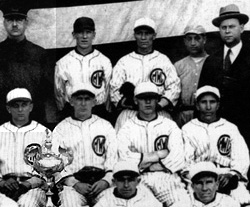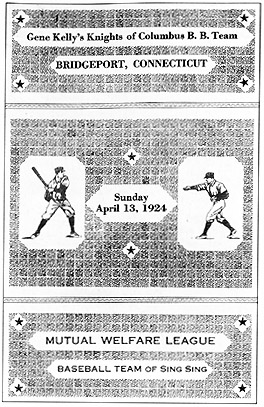What else my dad did in Sing Sing prison remains uncertain or unknown to me. The photograph of the Mutual Welfare League (MWL) player, who looks like my father, permits me to say that he might have been on that inmate team.
Inmate Harry N. Gold seated far left?

The inmate player with a resemblance to Harry N. Gold is seated far left and Jean Marie, daughter of Warden Lewis E. Lawes standing behind her, is seated right in this detail section from a Mutual Welfare League 1920s team photo reproduced in the Robert L. Gold's Westchester Historian article with the permission of the Lloyd Sealy Library, John jay College of Criminal Justice.To see the full photo, from which the detail section was taken, click the image above.
|
|
Thanks to Ellen Sexton, Reference Librarian, at the Lloyd Sealy Library, I now possess an enlarged photographic copy of the team picture and that player has a resemblance, though imperfect, to my dad.
Similarly, the baseballs autographed for my brother, Mert, suggest he might have had some connection to the exhibition games played between the inmate team and the New York Giants and Yankees, but they certainly do not provide any definitive proof.
In the late twenties, both teams came up from New York City to play baseball at Sing Sing. Hard as it is to imagine in the world of today’s sports millionaires, major league players, in the twenties, appeared in exhibition games on their days off to earn extra money. The Giants played the MWL team in 1924, 1927, and 1929, but the Yankees visited Ossining only once in the twenties.
On September 6, 1929, not long before the great stock market crash, the New York Yankees did play ball at Sing Sing. Babe Ruth hit three “titanic” homeruns in a game with the MWL team and one was reported to have gone 620 feet from home plate.
The ball flew over the center field prison wall, 40 feet high and 320 feet from home plate, continued over the New York Central railroad tracks and landed on a bluff below the prison’s administration building; Sing Sing was built on both sides of the railroad tracks.
Unfortunately, no box scores appear in the Citizen Sentinel’s
coverage of the exhibition games. Exploits, like Babe Ruth’s long homerun, and well-known mayor league players are mentioned in the newspaper, but little is included about the MWL team or the inmate players.
The same is true of the New York Times, which reports on Ruth’s record homerun “the longest non-stop flight of an object or person leaving Sing Sing,” but makes only perfunctory mention of the “MWL nine.” So, I have no way of knowing if my father played on the team or not.
Box scores are in the Citizen Sentinel for some of the games played between the inmates and other outside teams visiting Sing Sing. Baseball teams from Ossining, Westchester County, and even the borough of Brooklyn (The South Side Democratic Club) played at the prison all through the twenties. The newspaper box scores for those games do not include Harry Gold in the MWL lineup.
Without at least one mention of him in the Citizen Sentinel, I cannot say my dad ever played in an MWL game with the New York Giants, Yankees, or, for that matter, any other visiting team; I cannot even say he was on the inmate team. I want to believe he played ball at Sing Sing, but, to my chagrin, I cannot prove it.
The three autographed balls, however, suggest my father must have had some connection to the Mutual Welfare League Team. Since they were inscribed “To Mert” before being signed by the New York Giants and Yankees, they suggest that someone on or close to the inmate team got the balls autographed for my brother.
That someone obviously had access to the visiting teams to get all the players’ signatures on the balls in the short time they were at Sing Sing - before or after the game. The autographed baseballs alone do not prove that my father played on the MWL team but, considered along with the old team photograph, they offer a compelling possibility.
Other baseball-related views from
Images of America: Sing Sing Prison.

The above photo of Warden Lewis E. Lawes, right, with 1920s inmate baseball team is included in the NYCHS excerpts presentation of Guy Cheli's Images of America: Sing Sing Prison.
Below, also from Guy Cheli's Images of America: Sing Sing Prison book, is an image of the scorecard from the 1924 baseball season opening game at Sing Sing.
At the bottom of each main frame page in this current presentation is a link to access the NYCHS excerpts presentation of Guy Cheli's Images of America: Sing Sing Prison.

1924 Sing Sing Prison scorecard.
|
|
What Dad did in prison and how he spent the five years of his sentence are questions that still remain without reliable answers.
Without the inmate files, consumed in the fire of 1984, there is nowhere else to search for facts about my father and no one alive today who has information about his prison life. Sing Sing guards or officials and fellow inmates, who might have recalled something about his time among them are long gone.
I am left with too few memories and a picture of a player in an MWL baseball uniform who might have been my father. There is nothing else, not even the autographed baseballs from those years.
The search itself, if frustrating at first, was informative and satisfying in the end. I now know much more about the man who was my father. Hard facts have been added to my memories of what he and other people told me about his crimes and sentence in Sing Sing.
I also know his gambling, which would lead him to ceaseless “swindles” and five years in prison, was a lifetime fixation. It began even earlier than I had imagined and lasted until the final years of his life.

